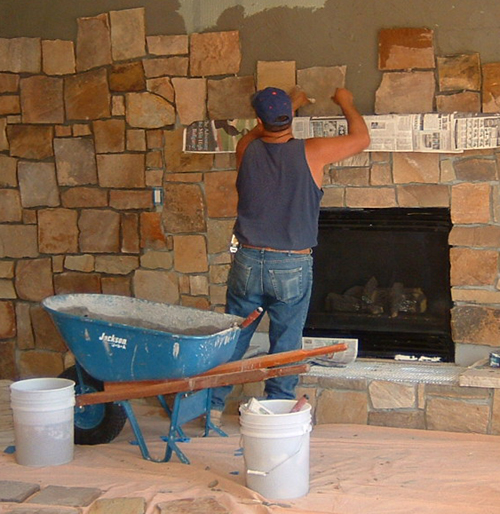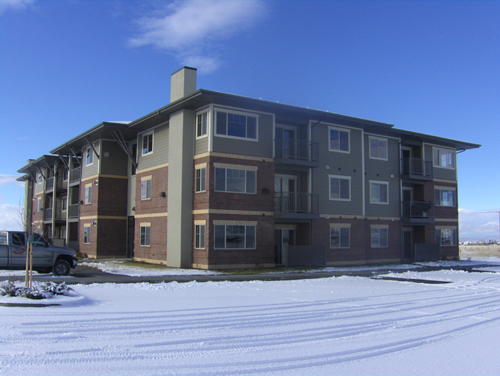Thin Brick and Thin-Cut Stone Take on Full-Dimension Masonry Products
Water Penetration Prevention
Controlling water penetration in thin veneer applications involves both drainage and waterproofing. Because all wall construction may potentially get water, good installation practices begin in the inner wall. Potential problems begin with failures in the moisture-resistant barrier, particularly failures in lapping or flashing around windows and wall bases, or in the existence of holes in the barrier itself.
There must be a quick exit for any water that has penetrated behind the brickwork. That is achieved through a properly designed and installed through-wall masonry flashing, which is an impermeable membrane that extends from the sheathing to the brickwork. Flashing should be placed at all points where the air space is closed off. Because there is considerable difficulty and expense in replacing flashing, quality materials such as sheet metals and bituminous membranes should be used. Architects are well advised to consider a final joint grouting, which is an extra measure of protection against moisture penetration.
According to the Rocky Mountain Masonry Institute, generally speaking, natural stone veneer applications are inherently weather-resistant. But in some instances, particularly at areas that receive constant wetting, including walls and sills, water-repellent treatments will help the wall resist moisture penetration and staining Breathable water repellents with a silane or siloxane base will penetrate into the surfaceof the veneer and act to shed water, while enabling the escape of watervapor from within the wall. Non-breathable repellents or sealers willcreate a film on the wall that will trap water inside the wall.
 |
Apply rock to wall and "wiggle" until set. Photo courtesy Robinson Brick |
Workmanship
It is essential that all voids are eliminated. The back of every rock must be completely embedded in mortar. Joints must be full and well tooled. Dry stack patterns are not recommended in climates with numerous freeze-thaw cycles without ensuring the dry voids are also full of mortar.
In general, thin rock units should be kept clean as work progresses. Mortar smears should be removed by gentle dry brushing at the end of work periods. For general cleaning, bucket and brush hand cleaning methods with non-acidic detergent cleaners is recommended. Pressure wash cleaning methods should not be used.
Maintenance Issues
Thin stone veneer products are virtually maintenance free. Paint, sealers or harsh cleaning products are unnecessary and can even be harmful. All that is generally required is periodic washing with mild soap or detergent and a soft bristle brush to remove surface dirt and dust. The stone or brick can be rinsed with a garden hose. Wire brushes should never be used, nor should acid or acid-based products. To prevent staining, some manufacturers do recommend sealers with a breathable saline base. Architects should note that sealers can darken the color of the stone, as well as retard the flow of moisture from the stone.
Because of its low absorption, high strength, and excellent resistance to weathering, natural thin stone will endure for decades, with a few simple caveats. Excess moisture should be kept from saturating the wall, with any sprinklers or downspouts adjusted to keep water from continuously touching the wall. Ivy and other vegetation should be removed. A gentle water spray should be sufficient to remove dust and dirt. Cracks due to the building shifting and settling should be re-pointed with new mortar to restore the wall's natural weather resistance.
Properly designed and installed, thin stone and brick veneers represent a solid resource for architects to meet aesthetic and sustainability goals at an affordable price. Architects should remain aware of the wide variety of styles and colors available in the market place, as well as the potential to customize thin veneer to a project's specifications.
Savings with Thin Brick |
Thin brick delivers the authenticity of full-size brick with a real opportunity for cost savings-as evidenced by the 96-unit Bozeman Peaks Condos just outside Bozeman, Montana. Bozeman Peaks was a four-phase project that required 46,000 thin brick units per phase. Because the use of thin brick veneer obviated the need to pour weight-bearing walls or provide any of the structural support needed for full-size veneer, architects were able to save over $157,000 in both structural and installation costs per phase, for a total of savings of $628,000. "Thin stone and thin brick veneer consistently contribute to value engineered savings," says Robinson Brick's Hambleton. |
 |
Photo courtesy Robinson Brick |








